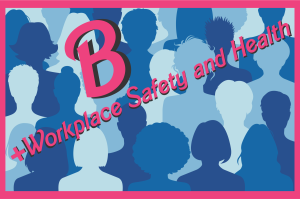Workplace Safety and Health in a Barbie World
Posted on by
As the occupational safety and health community continues to combat very real and serious hazards, we are closing out the summer with a little fun. This summer Barbie and friends have recaptured national attention breaking box office records with movie ticket sales exceeding one billion dollars in just a few weeks. While Barbie’s first “job” in 1960 was as a fashion designer, she went on to hold over 200 jobs[1] across various industries (of course with the corresponding outfits and accessories). While it appears Barbie has remained safe and healthy (not to mention the same age) her various jobs could have placed her at risk for a number of workplace safety and health issues.
We’re using some of Barbie’s many jobs to highlight resources available from the National Institute for Occupational Safety and Health (NIOSH) to help keep workers (including Barbie, Ken, and Skipper) safe and healthy.
Healthcare
Barbie has been a doctor, nurse, candy striper, paramedic, and a dentist. In 2022, 14.7 million people worked in healthcare occupations and 80% were women.[2] Healthcare workers face a wide range of hazards on the job including: sharps injuries, chemical and drug exposure, back injuries, latex allergies, violence, and stress. NIOSH has a health worker mental health initiative to address burnout and mental health issues. NIOSH also has resources for emergency medical service workers, dentists and a blog series on nurses.
Hearing Loss
Exposure to loud noise or certain chemicals while at work can damage hearing. Occupational hearing loss is one of the most common work-related illnesses and is permanent. Approximately 22 million US workers are exposed to hazardous noise levels at work each year.[3] While occupational hearing loss is a potential hazard in all industries and occupations, Barbie’s gigs as a rock star/rapper/singer could put her at risk for losing her hearing. Read more on related blogs Turn it Down: Reducing the Risk of Hearing Disorders Among Musicians and These Go to Eleven. Barbie could also be exposed to harmful noise levels in her jobs as a racecar driver, construction worker, soccer coach, and police officer.
Flight Attendant/ Pilot
Ever the world traveler and aviation enthusiast, Barbie also worked as a flight attendant and a pilot. These jobs also can present the risk for hearing loss as well as aircrew hazards such as cosmic ionizing radiation, reproductive health, circadian rhythm disruption, and more. NIOSH also has information on aviation safety including fatigue prevention for pilots and aviation safety in wildland firefighting.
Office Work
As an architect, business executive, entrepreneur, secretary, and travel agent Barbie could encounter hazards such as ergonomics and musculoskeletal disorders and indoor air quality as well as issues related to working from home and temporary/contingent workers (as both a worker and employer). Barbie can also benefit from the NIOSH small business resources as she has owned a fashion boutique, farmers’ market stall, dog day care, and ice cream cart.
Animal-related Occupations
Barbie’s love of animals naturally led her to careers as a veterinarian, dolphin trainer, zookeeper, animal rescuer, beekeeper, zoologist, entomologist, marine biologist, equestrian, cowgirl, and park ranger. Many of these jobs involve outdoor hazards including venomous snakes, spiders, and wildfire smoke.
Veterinarians can face ergonomic and noise hazards and are at risk of suicide and substance use disorders. Working with horses and livestock presents unique hazards as well, see the blogs Respiratory Hazards for Latino Horse Farm Workers; Safety and Health in the Horse-Racing Industry; and Improving the Safety and Health of Bison Handlers. Working with elephants can also pose a hazard as described in this blog on influenza-like Illness in a worker at a wildlife refuge.
Additional Jobs and Hazards
Some of Barbie’s other notable jobs where NIOSH has safety and health resources include: police officer, construction worker (maybe she even helped build her own dreamhouse), farmer, firefighter, chemist, teacher, and robotics engineer.
While you’d never know if by looking at her, Barbie is actually 64 years old. NIOSH has resources on productive aging and work which includes information for older drivers in the workplace (may also come in handy for cruising in her pink convertible). NIOSH also has resources on young worker safety and health for Barbie’s little sister, Skipper, since young workers have high rates of job-related injuries.
NIOSH research to address some of the unique hazards women may face in the workplace includes work-related reproductive health research and research to ensure equipment fits all workers and all body types see: One Size Does Not Fit All; NIOSH Protective Clothing Challenge; PPE Fit in the Construction Sector; and Benefits of Reduced Aerial Ladder Rung Spacing. As discussed in the blog The Role of Demographics in the Future of Work, women are disproportionately affected by workplace violence, with women of color and immigrant women facing additional forms of harassment and discrimination. They also experience more unstable and unpredictable work scheduling practices, negatively affecting their safety, health, and well-being, and that of their families.
NIOSH is committed to ensuring a safe and healthy workplace for all workers, including Barbie and her friends, and will continue to consider all workers in our research and prevention efforts.
Julie Tisdale-Pardi, MA, is the NIOSH Science Blog Coordinator and a Health Communication Specialist in the NIOSH Communication and Research to Practice Office.
Stephen R. Leonard is a Senior Multimedia Developer in the NIOSH Office of the Director.
Tanya Headley, MS, is a Senior Health Communication Specialist at NIOSH.
References
[1] Lisitza A [2023]. Barbie’s Career: A Comprehensive List of Every Job. BuzzFeed, July 18, https://www.buzzfeed.com/alexalisitza/list-every-job-barbie-had
[2] Smith S, Blank A [2023]. Healthcare Occupations: Characteristics of the Employed. U.S. Bureau of Labor Statistics, Spotlight on Statistics. https://www.bls.gov/spotlight/2023/healthcare-occupations-in-2022/home.htm
[3] Kerns E, Masterson EA, Themann CL, Calvert GM. (2018). Cardiovascular conditions, hearing difficulty and occupational noise exposure within U.S. industries and occupations. American Journal of Industrial Medicine, 61, 477-491. https://pubmed.ncbi.nlm.nih.gov/29537072/
Posted on by

